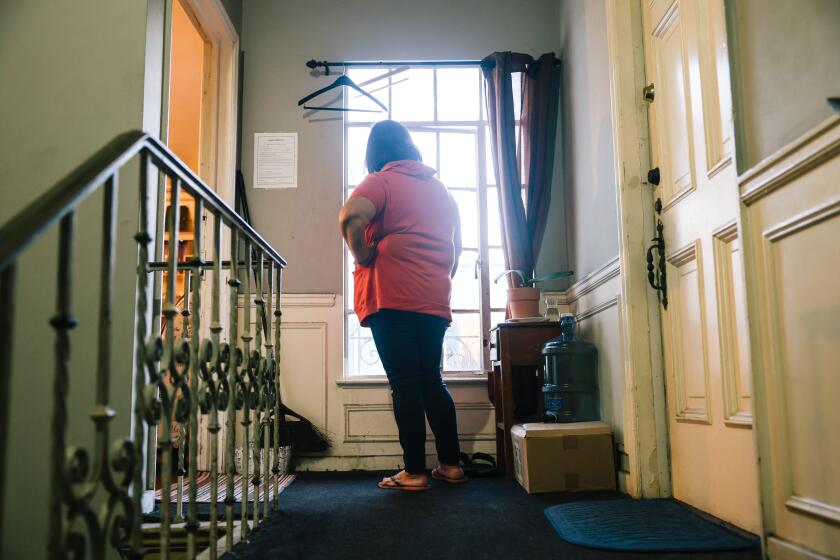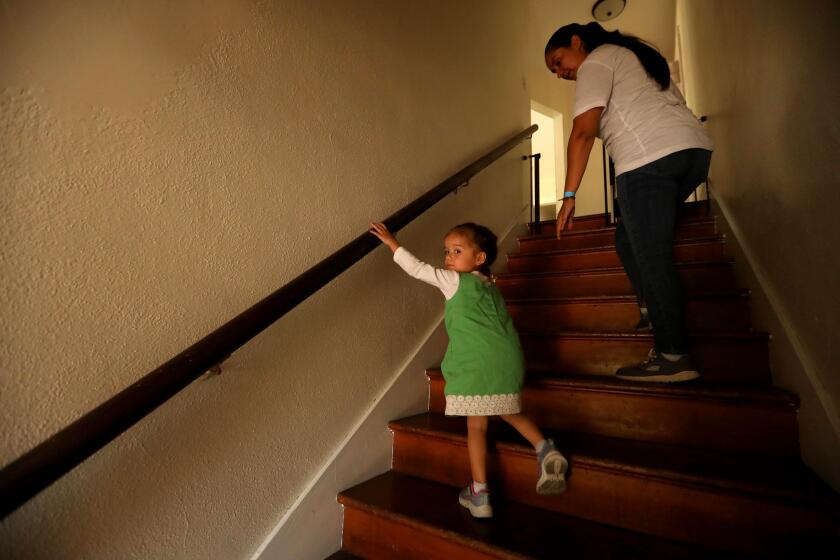Trial over mass evictions at Barrington Plaza could hinge on meaning of “permanent”

What does “permanent” mean?
For more than 100 people still living at the massive Westside apartment complex Barrington Plaza one year after their owner sought to evict them, a judge’s answer to that question, expected soon, is vital to their future.
People who live in rent-controlled properties, such as Barrington Plaza, enjoy special protections against eviction as a way of keeping tenants from being kicked out just to raise rents. Under L.A. city law, one legally allowed reason to evict is if an owner is going to remove a rental unit “permanently from rental housing use.”
In the case of Barrington Plaza, the owners say that’s exactly their plan — while they simultaneously acknowledge they might rent the units again after some years.
“The term ‘permanently’ does not mean forever,” the company’s lawyers argued in court filings.
That legal argument is now under consideration following a trial that started last month at the Santa Monica Courthouse. Lawyers for both sides presented closing arguments at the end of April, and Judge H. Jay Ford III’s decision is expected in the coming weeks.
Tenants and their advocates see the lawsuit as a crucial effort to defend rent control in Los Angeles. If companies can simply say they’re permanently removing units from the rental market, evict tenants and then re-rent the units, the rules have little or no meaning, they say.
A decision accepting the company’s position “could be devastating for tenants in L.A., for tenants all over the state who are in rent-controlled apartments,” said Peter Dreier, a professor at Occidental College.
Owner Douglas Emmett Inc., meanwhile, sees the case as a test of protections for landlords, who, it says, shouldn’t be forced to rent units they don’t want to rent.
State law grants landlords “the absolute right to exit the rental market, which means that the landlord’s motivation and reason for doing so does not matter,” the company argues in court filings.
At Barrington, company lawyers also say there is a compelling reason to evict the tenants: after two major fires in recent years, it needs to install fire sprinklers and make other fire safety upgrades to the property.
At the heart of the case are two laws — the state’s Ellis Act, which gives landlords the right to get out of the rental business, and the Los Angeles Rent Stabilization Ordinance, which controls rent increases, limits permissible evictions for tenants in rent stabilized units and addresses how the Ellis Act will be applied locally.
The Ellis Act has allowed thousands of L.A.’s rent-stabilized units to be taken off the market. A mother and son who fought back want others to know they can too.
The 1985 Ellis Act has been the bane of tenant advocates for years. Rather than protect small mom-and-pop landlords who no longer want to be in the rental business, advocates say, it is often used by large companies to turn rent-controlled properties to more profitable uses.
Across L.A., the Ellis Act has led to more than 13,200 rent-controlled units being taken off the market since July 2007, according to city data.
The city law, meanwhile, says that landlords who want to evict tenants under the Ellis Act must “in good faith” be planning to demolish a unit or permanently remove the unit from the rental market.
The tenants say the law is being misused so that the owners can remodel Barrington Plaza and raise rents in a neighborhood where studio apartments regularly rent for more than $2,000.
Nearly three-quarters of renters and those under 35 have considered moving out of Los Angeles because housing costs are too high, according to a new poll.
They point to presentations and plans the company shared in the years before it issued eviction notices to the complex’s 577 occupied units, in which it discussed upgrades to the property beyond the fire sprinklers.
One plan, described by company officials in 2020, was to “transform and upgrade the campus over the next several years,” including improvements to the garage, pool, landscaping and exterior facade, according to court filings.
“A landlord who is evicting its tenants under the Ellis Act to make repairs is not ‘going out of business.’ It is improving its property so it can increase its rents in the future, which is part of the business of landlording,” the tenants argued in a court filing.
They also point out that the company’s CEO said in an email just before the eviction notices were sent that it was a “very good assumption” that the rental units would be brought back online within 10 years.
In court, Judge Ford has said he agrees that there is “substantial evidence” that the company’s intent was to bring Barrington Plaza back as apartments.
The owners, meanwhile, argue it would still be within the law if it later re-rents the apartments.
They argue that the Ellis Act, which does not us the word “permanent,” preempts the city law, which does. And even if it is not preempted, the company says, “permanent” in its legal application to this case means “non-temporary,” or “indefinite,” not forever.
They point to provisions in the law that impose requirements on landlords who do re-rent properties following Ellis Act evictions.
For example, landlords who re-rent properties within five years of such an eviction must first offer to rent to tenants displaced by the eviction — as long as the tenants had indicated in writing that they wanted to be notified if the units were re-rented.
The tenants say these provisions were never meant to allow re-renting, but to provide remedies for displaced renters if they happened.
The company also says the work they are planning will be so extensive, the units are essentially being demolished and what is rebuilt will be something entirely different.
Installing sprinklers will include stripping the three towers down to “steel columns and concrete slabs” — work that is estimated to take three to five years, the company says.
The units, as they are now, will “not exist ever again,” the company’s CEO Jordan Kaplan testified at trial.
The plaza was built in the early 1960s without fire sprinklers at a time when the city did not require them, and it was later exempted from rules that they be installed. But two major fires, in 2013 and 2020, the last of which left one tenant dead, mean it’s no longer safe to continue renting the apartments without the sprinklers, the owners say.
In the year since the eviction notices were issued, hundreds of people have left Barrington Plaza. When the notices first appeared, there were nearly 600 occupied units at the plaza. Today, there are just over 100.
Those who remain call themselves “the holdouts.” The complex is different now than it was a year ago, said tenant Robert Lawrence. It can feel eerily abandoned at times. On some floors there are only one or two tenants left. The pool, which used to be packed on a warm day, is often empty now.
But there is also a closeness among those who stayed behind, determined to fight the evictions until the end, he said.
As they await a ruling, he said, “there’s a feeling of melancholia mixed with solidarity.”
“It’s a combination of stressful and this new found sense of community, almost family.”
More to Read
Sign up for Essential California
The most important California stories and recommendations in your inbox every morning.
You may occasionally receive promotional content from the Los Angeles Times.













